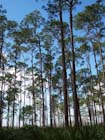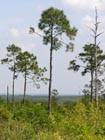Conservation Status

var. elliottii

var. densa
Pinus elliottii
Engelmann 1880
Common names
Slash pine, yellow slash pine, swamp pine; スラッシュマツ [Japanese].
Taxonomic notes
Syn: Pinus heterophylla (Elliott) Sudworth, 1893, not K. Koch, 1849; P.taeda Linnaeus var. heterophylla Elliott (Kral 1993). Two varieties, elliottii and densa.
Description
"Trees to 30 m; trunk to 0.8 m diam., straight to contorted; crown conic, becoming rounded or flattened. Bark orange- to purple-brown, irregularly furrowed and cross-checked into large, irregularly rectangular, papery-scaly plates. Branches spreading to ascending; twigs stout (to ca. 1 cm thick), orange-brown, aging darker brown, rough-scaly. Buds cylindric, silvery brown, 1.5-2 cm; scale margins fringed. Leaves 2 or 3 per fascicle, spreading or ascending, persisting ca. 2 years, 15-20(23) cm x 1.2-1.5 mm, straight, slightly twisted, pliant, yellow- to blue-green, all surfaces with stomatal lines, margins finely serrulate, apex abruptly acute to acuminate; sheath 1-2 cm, base persistent. Pollen cones cylindric, 30-40 mm, purplish. Seed cones maturing in 2 years, falling the year after seed-shed, single or in pairs, symmetric, lance-ovoid before opening, ovoid or ovoid-cylindric when open, (7-)9-18(-20) cm, light chocolate brown, on stalks to 3 cm; apophyses lustrous (as if varnished), slightly raised, strongly cross-keeled; umbo central, depressed-pyramidal, with short, stout prickle. Seeds ellipsoid, oblique-tipped; body 6-7mm, dark brown; wing to 20mm" (Kral 1993). See García Esteban et al. (2004) for a detailed characterization of the wood anatomy.
Distribution and Ecology
USA: Alabama, Florida, Georgia, Louisiana, Mississippi, South Carolina. Introduced in subtropical and warm temperate areas worldwide (Kral 1993); has naturalized in some areas. In South Africa, it is cultivated for timber, and has invaded forest margins and grassland in Mpumalanga. It has also invaded lower-altitude, higher-rainfall areas in Zimbabwe (Palgrave 2002). Hardy to Zone 9 (cold hardiness limit between -6.6°C and -1.1°C) (Bannister and Neuner 2001). See also Thompson et al. (1999).
Distribution data from USGS (1999).
Remarkable Specimens
The largest specimen is in var. elliottii, and the oldest in var. densa.
Ethnobotany
See the variety descriptions. The species is also useful in dendrochronology. Although it is not generally thought of as a long-lived species, Grissino-Mayer et al. (2001) used it to date episodes of its use in resin (turpentine) production. It has also been used in climate studies, stable isotope studies, and various work related to wood anatomy, as well as some rather unique things like a study of the effects of hurricane-driven salt spray on wood production.
Observations
See the variety descriptions.
Remarks
The epithet honors botanist Stephen Elliott (1771-1830).
Citations
Engelmann, George E. 1880. Revision of the genus Pinus, and description of Pinus Elliottii. Trans. Acad. Sci. St. Louis 4:161-190 (p. 186, plates 1-3). Available: Biodiversity Heritage Library, accessed 2024.11.22. Includes a splendid illustration.
Grissino-Mayer, H.D., Blount, H.C., Miller, A.C. 2001. Tree-ring dating and the ethnohistory of the naval stores industry in southern Georgia. Tree-Ring Research 57(1):3-13.
See also
FEIS database.
Huffman, J.M., W.J. Platt, H. Grissino-Mayer, and C.J. Boyce. 2004. Fire history of a barrier island slash pine (Pinus elliottii) savanna. Natural Areas Journal 24(3): 258-268. Available: http://www.stjosephbaypreserves.org/docs/NAAR2403_Huffman_258-268.pdf (2008.10.15).
Nelson, C. D., Nance, W. L. and Wagner, D. B. 1994. Chloroplast DNA variation among and within taxonomic varieties of Pinus caribaea and Pinus elliottii. Can. J. For Res. 24:424-426.
Nikles, D. G. 1966. Comparative variability and relationship of Caribbean Pine (Pinus caribaea Mor.) and Slash Pine (Pinus elliottii Engelm.). Ph.D. Thesis. NC State University. 201 pp.
Prasad and Iverson (1999).
The PROTA database account for this species (accessed 2019.02.28). PROTA accounts are focused on commercial forest uses in Africa, and typically include photographs, drawings, names, distribution, and a variety of information relevant to management of the species.
Wagner, D. B., Nance, W. L., Nelson, C. D., Li, T., Patel, R. N. and Govindaraju, D. R. 1991. Taxonomic patterns and inheritance of chloroplast variation in a survey of Pinus echinata, Pinus elliottii, Pinus palustris, and Pinus taeda. Canadian Journal of Forest Research 22:683-689.





